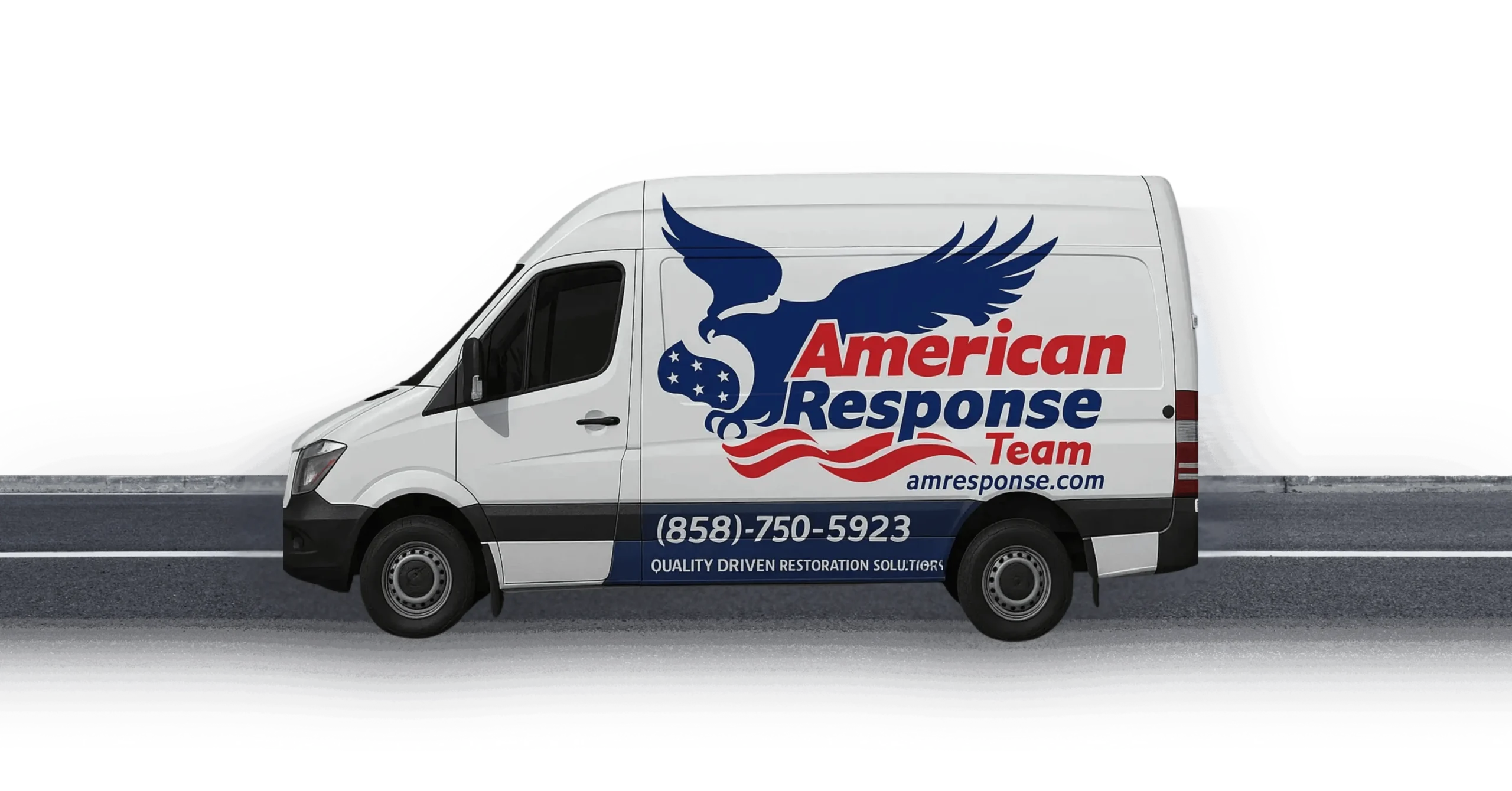When emergency water damage San Diego strikes your home, every minute counts. Whether from burst pipes, flooding, or storm damage, quick action can save thousands in repair costs and protect your family’s health. This emergency water damage San Diego guide provides the 7 critical steps every homeowner needs to know for immediate response
Water damage emergencies don’t wait for convenient times. Having a clear action plan before disaster strikes can mean the difference between minor repairs and major reconstruction. San Diego’s unique climate and weather patterns create specific challenges that require local expertise and rapid response.
What to Do in the First 24 Hours
The first 24 hours after emergency water damage San Diego incidents are absolutely critical. During this golden window, you can prevent secondary damage, protect your belongings, and minimize health risks. Here’s exactly what to do:
1. Ensure Safety First
Before entering any water-damaged area, assess the situation for immediate dangers. Turn off electricity to affected areas at the main breaker if water has reached electrical outlets, appliances, or wiring. Never enter standing water if electrical systems might be compromised.
Check for structural damage like sagging ceilings, warped floors, or damaged support beams. If you smell gas or suspect gas line damage, evacuate immediately and call 911. According to the EPA’s emergency response guidelines, safety must always be your first priority.
2. Stop the Water Source
If possible, locate and stop the source of water intrusion. This might mean:
- Shutting off the main water supply to your home
- Closing water valves to specific fixtures
- Covering holes in the roof with tarps
- Moving furniture and belongings to dry areas
The faster you stop the water flow, the less damage you’ll face. If you can’t locate the source or safely stop it, document everything for your insurance claim and call for professional emergency water damage response.
3. Document Everything Immediately
Take photos and videos of all damage before moving anything. Document:
- Water levels and affected areas
- Damaged belongings and structures
- The water source if visible
- Entry points where water came in
This documentation will be crucial for insurance claims and helps restoration professionals understand the scope of damage. Store digital copies in cloud storage to prevent loss.
4. Begin Water Removal
Start removing standing water immediately using:
- Wet/dry vacuums for smaller areas
- Mops and buckets for accessible areas
- Pumps for larger volumes (rent if needed)
Remove water-damaged items like carpets, rugs, and furniture cushions. The faster you remove water, the better chance you have of saving materials and preventing mold growth.
5. Promote Air Circulation
Open windows and doors if weather permits to increase ventilation. Set up fans to promote air movement and speed drying. Dehumidifiers help remove moisture from the air, reducing humidity levels that encourage mold growth.
The CDC emphasizes that proper ventilation is essential to prevent mold development, which can begin within 24-48 hours in humid conditions.
6. Contact Your Insurance Company
Call your insurance company within 24 hours to report the emergency water damage San Diego incident. Many policies require prompt notification to ensure coverage. Ask about:
- Coverage for temporary housing if needed
- Approved restoration contractors
- Documentation requirements
- Claim number and adjuster contact information
Keep detailed records of all communications with your insurance company. For help with insurance claims, read our guide on how to deal with insurance after water damage.
7. Remove Contaminated Materials
Remove and dispose of items that cannot be properly cleaned and dried:
- Drywall that has been saturated
- Insulation that got wet
- Carpeting and padding
- Personal items that absorbed contaminated water
Bag contaminated materials and remove them from your home promptly. Wear protective equipment including gloves, masks, and eye protection during cleanup.
When to Call Professional Help
While these initial steps are crucial, professional emergency water damage San Diego restoration often becomes necessary. Call professionals immediately if:
Water Category Assessment
Category 1 (Clean Water): From sources like broken supply lines or sink overflows. You may handle small amounts yourself, but professional drying ensures complete moisture removal.
Category 2 (Gray Water): Contains contaminants from sources like washing machine overflows or toilet bowl overflows (no feces). Professional cleanup is recommended to ensure safe decontamination.
Category 3 (Black Water): Highly contaminated water from sewage backups, flooding, or standing water. Professional cleanup is essential for health and safety. This requires specialized sewage cleanup services with proper safety protocols.
Extent of Damage
Call professionals when:
- Water covers more than 100 square feet
- Water has been standing for more than 24 hours
- Structural materials are saturated
- HVAC systems are affected
- You suspect hidden moisture in walls or floors
Professional water damage restoration companies have industrial-grade equipment including:
- Powerful extraction units
- Commercial dehumidifiers
- Air movers and fans
- Moisture detection technology
- Antimicrobial treatments
Watch our process to understand how professional restoration works and why it’s often necessary for complete recovery.
Health and Safety Concerns
Contact professionals immediately if:
- Anyone in your home has respiratory issues, allergies, or compromised immune systems
- The water source is contaminated
- You notice signs of electrical damage
- Strong odors develop
- You see any signs of mold growth
Professional restoration ensures proper sanitization and reduces health risks associated with water damage.
San Diego-Specific Weather Risks
San Diego’s Mediterranean climate and unique geography create specific water damage risks that homeowners must understand:
Atmospheric Rivers
San Diego faces increasing threats from atmospheric rivers – narrow corridors of concentrated moisture that can dump several inches of rain in short periods. The National Weather Service San Diego regularly issues flood watches during these events.
These weather systems can cause:
- Flash flooding in urban areas
- Overwhelmed storm drains
- Hillside erosion and mudflows
- Roof leaks from heavy rainfall
Recent atmospheric river events have caused significant flooding in areas like Mission Valley, Scripps Ranch, and parts of North County San Diego.
Santa Ana Wind Events
Strong Santa Ana winds can damage roofs, break trees, and cause power outages that lead to water damage from:
- Roof damage allowing rain infiltration
- Broken pipes from power outages affecting heating systems
- Storm debris blocking drainage systems
Coastal Influences
San Diego’s coastal location creates unique challenges:
- Salt air accelerates corrosion of plumbing and roofing materials
- Marine layer moisture can contribute to chronic dampness issues
- Storm surge during winter storms affects low-lying coastal areas
Fire Season Impacts
Wildfire damage to watersheds increases flood risk during subsequent rain events. Areas like:
- Rancho Bernardo
- Scripps Ranch
- East County communities
Face elevated flood risk after nearby wildfires due to reduced vegetation and soil stability.
Understanding these regional risks helps homeowners prepare better for emergency water damage San Diego events. Consider our emergency response protocol specifically designed for San Diego conditions.
Insurance Documentation Requirements
Proper documentation can make the difference between a smooth insurance claim and a denied payout. Here’s what San Diego homeowners need to know:
Immediate Documentation
Before Cleanup:
- Take wide-angle photos showing the full scope of damage
- Capture close-up images of specific damage to materials and belongings
- Record video walkthroughs with narration describing what you see
- Document water levels with measuring tools visible in photos
During Cleanup:
- Photograph the water source and cause of damage
- Document your cleanup efforts with timestamped photos
- Keep receipts for all emergency supplies and equipment rentals
- Record time spent on cleanup activities
Required Information for Claims
Insurance companies typically require:
- Date and time damage was discovered
- Cause of the water damage
- Steps taken to mitigate further damage
- List of damaged items with estimated values
- Estimates from licensed contractors
Working with Adjusters
When the insurance adjuster arrives:
- Provide organized documentation
- Walk them through the damaged areas
- Show before and after photos
- Present receipts for emergency expenses
- Ask about coverage for temporary housing if needed
Many San Diego homeowners benefit from working with restoration companies that understand local insurance requirements. Companies approved by programs like Contractor Connection have established relationships with insurance providers and understand regional claim processes.
For detailed guidance on insurance claims, review our comprehensive article on understanding different types of water damage for insurance purposes.
Documentation Timeline
First 24 Hours:
- Initial damage photos and videos
- Insurance company notification
- Emergency mitigation documentation
Days 1-3:
- Detailed inventory of damaged items
- Contractor estimates
- Additional evidence of damage extent
Ongoing:
- Progress photos during restoration
- Receipts for all related expenses
- Communication logs with insurance company
Preventing Secondary Damage
Secondary damage often costs more than the original water damage. Here’s how to prevent it:
Mold Prevention
Mold can begin growing within 24-48 hours in San Diego’s moderate humidity. Prevent mold by:
- Maintaining indoor humidity below 50%
- Ensuring complete drying of all materials
- Using antimicrobial treatments on affected surfaces
- Monitoring for musty odors that indicate hidden moisture
The CDC guidelines for mold cleanup emphasize that people with asthma, COPD, or compromised immune systems should not participate in cleanup activities.
Structural Protection
Protect your home’s structure by:
- Supporting sagging drywall or ceilings
- Removing weight from water-weakened floors
- Ventilating wall cavities to prevent trapped moisture
- Monitoring for signs of structural shifting or settling
Electronic Equipment
Protect electronics and appliances by:
- Disconnecting power to affected devices
- Moving electronics to dry areas immediately
- Having HVAC systems professionally inspected before restarting
- Documenting all affected electronics for insurance claims
HVAC System Protection
Water damage to HVAC systems requires special attention:
- Turn off systems if any water contact is suspected
- Have ductwork professionally cleaned and sanitized
- Replace filters immediately after any water exposure
- Ensure complete system drying before restart
Professional restoration companies use specialized equipment like thermal imaging cameras to detect hidden moisture that could cause ongoing problems.
Long-term Monitoring
Even after initial cleanup:
- Check for new stains or discoloration
- Monitor humidity levels with hygrometers
- Watch for new odors or signs of mold
- Have professional mold inspections if you suspect hidden moisture
For comprehensive information about preventing secondary damage, read our detailed guide on mold after water damage timeline and prevention strategies.
Expert Help When You Need It Most
Emergency water damage San Diego requires immediate action and often professional expertise. American Response Team provides 24/7 emergency response throughout San Diego County, including La Jolla, Vista, Carlsbad, Oceanside, and Escondido.
Our certified technicians respond quickly with professional-grade equipment and local expertise. We work directly with insurance companies and follow IICRC standards for water damage restoration.
Don’t let emergency water damage San Diego destroy your home and peace of mind. Following these 7 critical steps protects your property, but professional help ensures complete restoration and prevents costly secondary damage.
Take Action Now: If you’re experiencing emergency water damage San Diego, call 858-750-5923 immediately for rapid response. For non-emergency questions about water damage prevention or restoration, contact our team for expert guidance tailored to San Diego’s unique conditions.
Remember: quick action saves money, protects health, and prevents extensive damage. Keep this guide accessible and share it with family members so everyone knows what to do when emergency water damage San Diego strikes.

